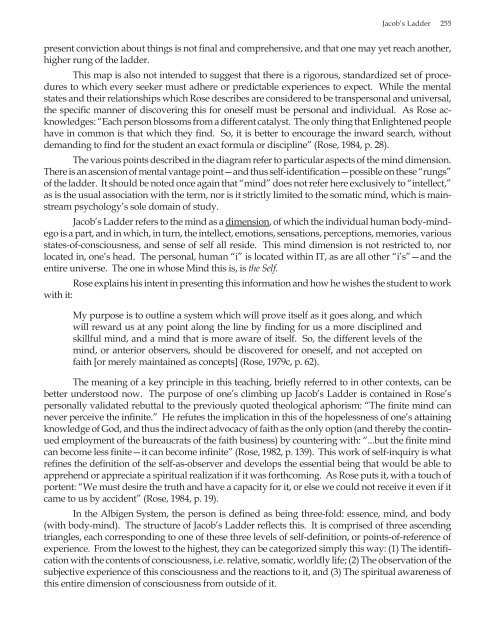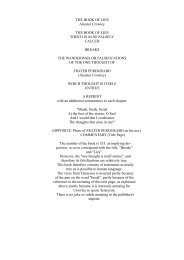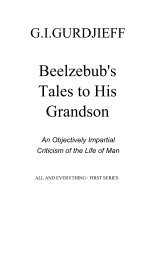Richard Rose’s Psychology of the Observer The Path to Reality Through the Self
John-Kent-Richard-Rose's-Psychology-of-Observer-Path-to-Reality-Thru-the-Self
John-Kent-Richard-Rose's-Psychology-of-Observer-Path-to-Reality-Thru-the-Self
Create successful ePaper yourself
Turn your PDF publications into a flip-book with our unique Google optimized e-Paper software.
Jacob’s Ladder 255<br />
present conviction about things is not final and comprehensive, and that one may yet reach ano<strong>the</strong>r,<br />
higher rung <strong>of</strong> <strong>the</strong> ladder.<br />
This map is also not intended <strong>to</strong> suggest that <strong>the</strong>re is a rigorous, standardized set <strong>of</strong> procedures<br />
<strong>to</strong> which every seeker must adhere or predictable experiences <strong>to</strong> expect. While <strong>the</strong> mental<br />
states and <strong>the</strong>ir relationships which Rose describes are considered <strong>to</strong> be transpersonal and universal,<br />
<strong>the</strong> specific manner <strong>of</strong> discovering this for oneself must be personal and individual. As Rose acknowledges:<br />
“Each person blossoms from a different catalyst. <strong>The</strong> only thing that Enlightened people<br />
have in common is that which <strong>the</strong>y find. So, it is better <strong>to</strong> encourage <strong>the</strong> inward search, without<br />
demanding <strong>to</strong> find for <strong>the</strong> student an exact formula or discipline” (Rose, 1984, p. 28).<br />
<strong>The</strong> various points described in <strong>the</strong> diagram refer <strong>to</strong> particular aspects <strong>of</strong> <strong>the</strong> mind dimension.<br />
<strong>The</strong>re is an ascension <strong>of</strong> mental vantage point—and thus self-identification—possible on <strong>the</strong>se “rungs”<br />
<strong>of</strong> <strong>the</strong> ladder. It should be noted once again that “mind” does not refer here exclusively <strong>to</strong> “intellect,”<br />
as is <strong>the</strong> usual association with <strong>the</strong> term, nor is it strictly limited <strong>to</strong> <strong>the</strong> somatic mind, which is mainstream<br />
psychology’s sole domain <strong>of</strong> study.<br />
Jacob’s Ladder refers <strong>to</strong> <strong>the</strong> mind as a dimension, <strong>of</strong> which <strong>the</strong> individual human body-mindego<br />
is a part, and in which, in turn, <strong>the</strong> intellect, emotions, sensations, perceptions, memories, various<br />
states-<strong>of</strong>-consciousness, and sense <strong>of</strong> self all reside. This mind dimension is not restricted <strong>to</strong>, nor<br />
located in, one’s head. <strong>The</strong> personal, human “i” is located within IT, as are all o<strong>the</strong>r “i’s”—and <strong>the</strong><br />
entire universe. <strong>The</strong> one in whose Mind this is, is <strong>the</strong> <strong>Self</strong>.<br />
Rose explains his intent in presenting this information and how he wishes <strong>the</strong> student <strong>to</strong> work<br />
with it:<br />
My purpose is <strong>to</strong> outline a system which will prove itself as it goes along, and which<br />
will reward us at any point along <strong>the</strong> line by finding for us a more disciplined and<br />
skillful mind, and a mind that is more aware <strong>of</strong> itself. So, <strong>the</strong> different levels <strong>of</strong> <strong>the</strong><br />
mind, or anterior observers, should be discovered for oneself, and not accepted on<br />
faith [or merely maintained as concepts] (Rose, 1979c, p. 62).<br />
<strong>The</strong> meaning <strong>of</strong> a key principle in this teaching, briefly referred <strong>to</strong> in o<strong>the</strong>r contexts, can be<br />
better unders<strong>to</strong>od now. <strong>The</strong> purpose <strong>of</strong> one’s climbing up Jacob’s Ladder is contained in <strong>Rose’s</strong><br />
personally validated rebuttal <strong>to</strong> <strong>the</strong> previously quoted <strong>the</strong>ological aphorism: “<strong>The</strong> finite mind can<br />
never perceive <strong>the</strong> infinite.” He refutes <strong>the</strong> implication in this <strong>of</strong> <strong>the</strong> hopelessness <strong>of</strong> one’s attaining<br />
knowledge <strong>of</strong> God, and thus <strong>the</strong> indirect advocacy <strong>of</strong> faith as <strong>the</strong> only option (and <strong>the</strong>reby <strong>the</strong> continued<br />
employment <strong>of</strong> <strong>the</strong> bureaucrats <strong>of</strong> <strong>the</strong> faith business) by countering with: “...but <strong>the</strong> finite mind<br />
can become less finite—it can become infinite” (Rose, 1982, p. 139). This work <strong>of</strong> self-inquiry is what<br />
refines <strong>the</strong> definition <strong>of</strong> <strong>the</strong> self-as-observer and develops <strong>the</strong> essential being that would be able <strong>to</strong><br />
apprehend or appreciate a spiritual realization if it was forthcoming. As Rose puts it, with a <strong>to</strong>uch <strong>of</strong><br />
portent: “We must desire <strong>the</strong> truth and have a capacity for it, or else we could not receive it even if it<br />
came <strong>to</strong> us by accident” (Rose, 1984, p. 19).<br />
In <strong>the</strong> Albigen System, <strong>the</strong> person is defined as being three-fold: essence, mind, and body<br />
(with body-mind). <strong>The</strong> structure <strong>of</strong> Jacob’s Ladder reflects this. It is comprised <strong>of</strong> three ascending<br />
triangles, each corresponding <strong>to</strong> one <strong>of</strong> <strong>the</strong>se three levels <strong>of</strong> self-definition, or points-<strong>of</strong>-reference <strong>of</strong><br />
experience. From <strong>the</strong> lowest <strong>to</strong> <strong>the</strong> highest, <strong>the</strong>y can be categorized simply this way: (1) <strong>The</strong> identification<br />
with <strong>the</strong> contents <strong>of</strong> consciousness, i.e. relative, somatic, worldly life; (2) <strong>The</strong> observation <strong>of</strong> <strong>the</strong><br />
subjective experience <strong>of</strong> this consciousness and <strong>the</strong> reactions <strong>to</strong> it, and (3) <strong>The</strong> spiritual awareness <strong>of</strong><br />
this entire dimension <strong>of</strong> consciousness from outside <strong>of</strong> it.




